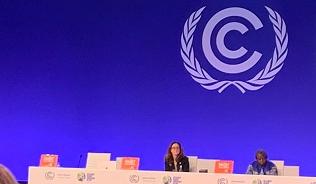environmental SCIENTIST | Communicating Environmental Science | October 2012
Clare Wilkinson and Emma Weitkamp give guidance on how best to communicate with policy-makers.
In recent years environmental scientists and researchers have been increasingly encouraged to communicate about their research to a variety of audiences, including policy-makers, pressure groups and more general audiences. In the UK, approaches such as the Research Council’s Pathways to Impact incentivise researchers to consider plans for public engagement, as well as influences on policy and a range of other social and economic impacts. In addition, in 2014 the Research Excellence Framework will, for the first time, seek to consider how researchers have created impact from their past research.
 At the same time, the concept of evidence-based policy has emerged, where scientific evidence is seen to play a key role the policy-making process. Drawing on the concept of evidence- based medicine, evidence-based policy-making is gaining ground amongst local, national and international policy-makers. With policy-makers increasingly open to incorporating scientific evidence at all stages of the policy cycle (see Figure), researchers now need to consider how best to reach this audience.
At the same time, the concept of evidence-based policy has emerged, where scientific evidence is seen to play a key role the policy-making process. Drawing on the concept of evidence- based medicine, evidence-based policy-making is gaining ground amongst local, national and international policy-makers. With policy-makers increasingly open to incorporating scientific evidence at all stages of the policy cycle (see Figure), researchers now need to consider how best to reach this audience.
We know that a variety of factors, beyond these institutional agendas, encourage scientists and researchers to communicate about their work and participate in public engagement activities and many of these factors also apply to motivations and barriers to communicating with policy-makers. Individual motivations play a large role, such as researchers’ attitudes to the role of public engagement with scientific issues and confidence in being able to engage via such settings2. From a professional perspective, scientists are often motivated to increase understanding and information around their fields of work, in particular in socially relevant areas3. However there can also be barriers, such as concerns about the time it takes and potential rewards4. Communicating beyond one’s professional barriers can be a mystifying and daunting process, in particular when environmental issues, such as ‘Climategate’ reach the front pages5. However, communication, whether direct or via popular media, is perceived to play a crucial role in setting policy-makers’ agendas.
For members of the scientific community building a professional reputation, publishing in high-profile journals or creating knowledge brokerage opportunities, have all been identified as ways via which policy-makers may be accessed6. However the communication trail is far from straightforward and the expectation of a linear or transmission model from scientist to policy-maker has long been rejected. From the policy-makers’ perspective the difficulty in finding and accessing the most relevant reports, the rare use of peer-reviewed journal articles, and the problem in identifying appropriate experts, in addition to the pressing time frame in which some of this information is often needed can create problems8. Through our work with policy-makers at national and European levels, we have developed seven key issues researchers need to consider when seeking to engage policy-makers with their research9.
- Know your policy-maker – knowing who to talk to, when to talk to them and what they would find useful for policy, can improve communication.
- Know the policy areas – different areas within environmental policy-making have different evidence needs (e.g. in terms of quantitative versus qualitative data), recentness, and scope (e.g. European, national or local scale) .
- Consider policy stage – different kinds of evidence are needed at different stages of the policy cycle, for example a broad analysis of issues may be needed during policy formulation, while impact analysis may be more useful during the evaluation stages. Knowing what policies are upcoming or in progress can also help you tailor your communications.
- Understand the science–policy relationships – policy-makers may see science as primarily raising awareness of policy issues and impacts, or evaluating policy assumptions. Working with science, the role of policy is then to translate this into behavioural change and acceptance from the public.
- Assess the policy relevance of research – placing research evidence in a context that is clearly relevant to policy helps policy-makers to engage with findings. This can be by making clear links between drivers and impacts of policy and your research.
- Consider indirect routes – consultants are often used by policy-makers to gather evidence. Environmental scientists could capitalise on these links by choosing communication strategies that reach consultants as well as directly reaching out to the policy community. For example, researchers may choose to make links with environmental consultants providing services related to their field of expertise. Establishing such relationships can provide formal and informal opportunities to inform their working practices.
- Think about long-term implications – your research may not end up directly quoted in policy, but it may be the spark which spurs policy-makers to commission further research.
It is also worth noting that communication between the research and policy communities should not be seen as one way. Involvement with policy-makers can, and perhaps should, influence research itself. As such, opportunities for communicating and engaging with policy-makers should not be viewed as a top-down or one-way approach, but as an exchange of information, ideas and needs. Involving policy-makers at the early stages of research projects can help shape these to produce evidence that is more suited to policy-makers’ needs. Such research has a greater chance of directly influencing policy.
Knowledge brokers can play a role in facilitating the transfer of evidence from the scientific to the policy community: “The intent of knowledge brokering for developing environmental policy is to enable decision makers to acquire, value and consider expertise that they would not otherwise obtain or incorporate into their decision making.” (Michaels, 200910)
An example of such a knowledge-brokering service is the Science for Environment Policy News Alert service. Science for Environment Policy11 is a free news and information service designed to help policy-makers keep up to date with the latest environmental research that supports the design, implementation and regulation of effective policies. It was first established in 2005, when it comprised an emailed bulletin (the News Alert) and an online archive for News Alert articles. Science for Environment Policy has since expanded to offer a range of outputs under a range of headings including Thematic Issues, an online database of policy-relevant studies (the Research Repository), briefing papers on emerging topics (Future Briefs) and In-depth Reports on key policy topics.
A recent evaluation of the service indicates that it is highly valued by both policy-makers and researchers as a mechanism that facilitates the transfer of research evidence into the policy community. Readers report that the service makes it easier to use science in policymaking and helps them to keep track of the latest scientific research that would be challenging to do individually. Researchers (24 per cent) report being contacted by policy-makers when their research has been reported in the service, suggesting that it is acting as a mediator between these communities. Specialist media, such as Science for Environment Policy, offer an opportunity for researchers to reach out to the policy community, providing a relatively simple way to begin the process of engaging policy-makers with research. This could be supplemented with more targeted strategies designed to gain the attention of specific policy-makers.
In summary, whilst communicating about research can have its challenges, all sorts of mediating groups and organisations are available to support researchers. This includes providing training (for example, the European Commission maintains a useful guide for science communication and journalism courses across Europe12), resources and support (from the UK-based National Coordinating Centre for Public Engagement, for example13 or making the effort to communicate a specific piece of research directly to policy-makers. There is no reason why researchers and scientists cannot also play a role in engaging policy-makers, as well as broader audiences, with the impacts of their research.
Dr Clare Wilkinson is a Senior Lecturer in Science Communication whose research interests include the relationship between academia and society, and public involvement in engagement processes. She is Programme Manager for two communication-based postgraduate courses and has provided continuing professional development for a variety of individuals and organisations. Clare is based at the Science Communication Unit, UWE, Clare.Wilkinson@uwe.ac.uk.
Dr Emma Weitkamp is a Senior Lecturer in Science Communication particularly interested in how context can be used to facilitate engagement with research and controversial issues. Current projects include the Science for Environment Policy and SCOOP projects, which seek to facilitate the transfer of research into the policy community, and creative projects that seek to engage young people with science using narrative and storytelling, particularly in online environments (e.g. ScienceComics and SpaceJunkies). Emma is also based at the Science Communication Unit, UWE,Emma.Weitkamp@uwe.ac.uk.
1.Young, E., and Quinn, L. (2002) Writing Effective Public Policy Papers. www.gsom.spbu.ru/files/upload/bachelor/courses/spring2009/public_finance.... Open Society Institute, Budapest.
2.Poliakoff, E., and Webb, T.L. (2007) What factors predict scientists’ intentions to participate in public engagement of science activities? Science Communication, 29 (2) pp242–263.
3.Royal Society (2006) Science communication: Survey of factors affecting science communication by scientists and engineers. www.royalsociety.org/uploadedFiles/Royal_Society_Content/Influencing_Pol....
4.Claessens, M. (2008) ‘European trends in science communication’ in Cheng, D., Claessens, M., Gascoigne, N., Metcalfe, J., Schiele, B., and Shi, S. (eds.), Communicating science in social contexts: New models, new practices. Springer, New York.
5.Grand, A., Wilkinson, C., Bultitude, K., and Winfield, A. (2012) Open Science: A New “Trust Technology”?, Science Communication, 34 (5) pp679–689.
6.Scott, A. (2006) Communication on Environmental Research at the Science–Policy Interface (CSPI); workshop 28–29 November. ESF and COST, Brussels.
7.Lövbrand, E. (2007) Pure science or policy involvement? Ambiguous boundary-work for Swedish carbon cycle science. Environmental Science and Policy, 10 (1), pp39–47.
8.Holmes, J., and Clarke, R. (2008) Enhancing the use of science in environmental policy-making and regulation. Environmental Science and Policy, 11 (8) pp702–711.
9.Davenport, F., Kilfoyle, M., Quick, F., and Weitkamp, E. (2010) Environmental Research: An analysis of policymakers’ needs. European Communication Research and Education Association, Hamburg, 12–14 October.
10.Michaels, S. (2009) Matching knowledge brokering strategies to environmental policy problems and settings. Environmental Science and Policy, 12 (7) pp994–1011.
11.Science for Environment Policy. www.ec.europa.eu/environment/integration/research/newsalert/latest_alert... (Accessed 9 October 2012).
12.DG Research, European Guide to Science Journalism Training (2010) www.ec.europa.eu/research/conferences/2007/bcn2007/guide_to_science_jour....
13.National Co-ordinating Centre for Public Engagement. www.publicengagement.ac.uk/ (Accessed 9 October 2





